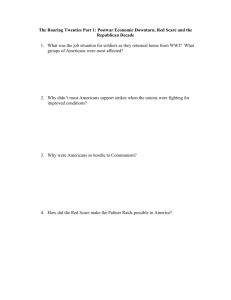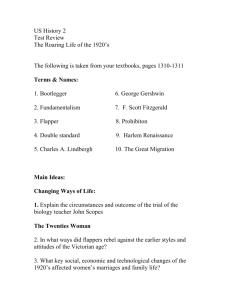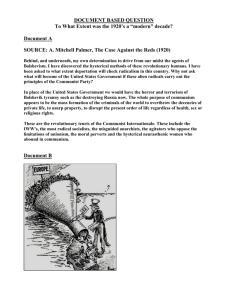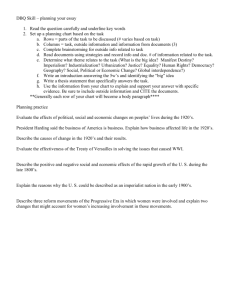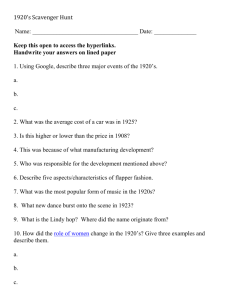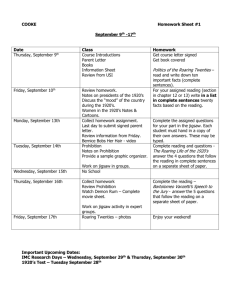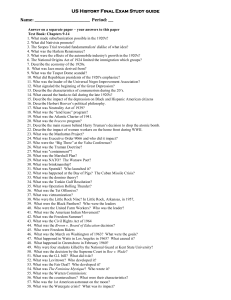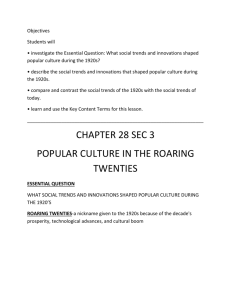Chapter 25: Transition to Modern America
advertisement
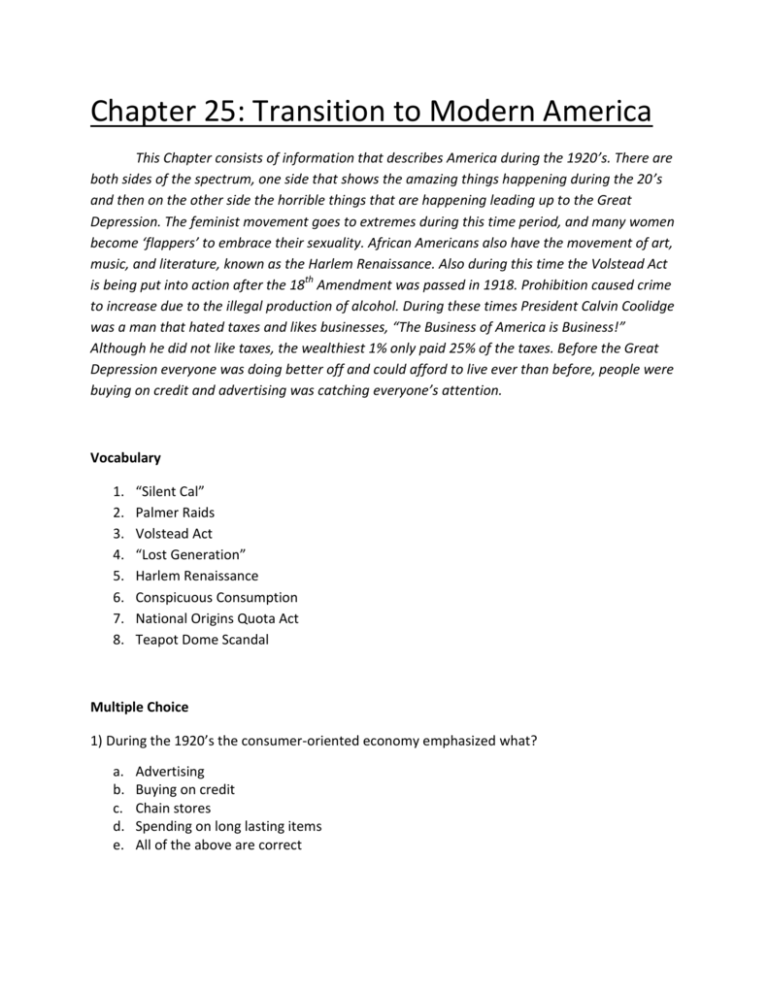
Chapter 25: Transition to Modern America This Chapter consists of information that describes America during the 1920’s. There are both sides of the spectrum, one side that shows the amazing things happening during the 20’s and then on the other side the horrible things that are happening leading up to the Great Depression. The feminist movement goes to extremes during this time period, and many women become ‘flappers’ to embrace their sexuality. African Americans also have the movement of art, music, and literature, known as the Harlem Renaissance. Also during this time the Volstead Act is being put into action after the 18th Amendment was passed in 1918. Prohibition caused crime to increase due to the illegal production of alcohol. During these times President Calvin Coolidge was a man that hated taxes and likes businesses, “The Business of America is Business!” Although he did not like taxes, the wealthiest 1% only paid 25% of the taxes. Before the Great Depression everyone was doing better off and could afford to live ever than before, people were buying on credit and advertising was catching everyone’s attention. Vocabulary 1. 2. 3. 4. 5. 6. 7. 8. “Silent Cal” Palmer Raids Volstead Act “Lost Generation” Harlem Renaissance Conspicuous Consumption National Origins Quota Act Teapot Dome Scandal Multiple Choice 1) During the 1920’s the consumer-oriented economy emphasized what? a. b. c. d. e. Advertising Buying on credit Chain stores Spending on long lasting items All of the above are correct 2) Calvin Coolidge ____. a. b. c. d. e. was friendly to American business interests was corrupt, similar to Harding ran for president again and hardly won was a workaholic president presided over the American involvement in WWI 3) During the 1920’s, the Democratic Party ____. a. b. c. d. e. won only one presidential election gained new voters in rural areas gained a vast number of new voters of ethnic groups in the cities agreed on all political topics none of the above 4) Why did prohibition (18th Amendment) fail? a. b. c. d. e. Rural America did not support it It cost too much to enforce the laws Mobs controlled illegal liquor production American population was decreasing due to the lack of alcohol Most Americans believed it interfered with their personal freedoms 5) Towards the end of the 1920’s, what was the largest industry in America? a. b. c. d. e. Railroads Steel Automobiles Radios Oil 6) The Harlem Renaissance refers to what? a. b. c. d. e. A festival where people dress up and dance The most famous jazz ensemble during the 1920’s The “Lost Generation” of writers who moved to Europe The African American movement in art, literature, and music All of the ethnic mobs coming together DBQ 1) After reading the following documents do you believe the 1920’s can be either described as the Roaring Twenties or the Terrible Twenties? Document A Song of the Times (1925) Flappers are we Flappers are we Flappers and fly and free. Never too slow All on the go Petting parties with the smarties. Dizzy with dangerous glee Puritans knock us Because the way we're clad. Preachers all mock us Because we're not bad. Most flippant young flappers are we! (From Tea for Two in the musical, No, No, Nanette, written by Vincent Youmas) Document B Document C Even where there were no such outrages, there was at least the threat of them.. The whiterobed army paraded, the burning cross glowed across the valley people whispered to one another in the darkness and wondered "who they were after this time," and fear and suspicion ran from house to house. Furthermore, criminals and gangs of hoodlums quickly learned to take advantage of the Klan's existence; if they wanted to burn someone's barn or raid the slums beyond the railroad tracks, they could do it with impunity now: would not the Klan be held responsible? Anyone could chalk the letters K.K.K. on a fence and be sure that the sheriff would move warily. Thus, as in the case of the Red hysteria, a movement conceived in fear perpetuated fear and brought with it all manner of cruelties and crimes. (Excerpted from Frederick Lewis Allen, Only Yesterday: An Informal History of the 1920's (New York: Harper and Row, 1931): pp. 49-50.) Document D (From Mabel Newcomer, A Century of Higher Education for American Women (New York: Harper and Row, 1959, p. 46.) Graphic Organizer Answers Vocabulary 1. Calvin Coolidge was the 30th President of the US. He was friendly to American business interest and was against taxes. 2. Within 5 months there were more than 4,000 immigrant arrests. 3. Passed after the 18th Amendment to nationally prohibit alcohol. 4. A term made popular by Ernest Hemingway to describe the generation that came to age after WWI and before the Great Depression. 5. An African American movement in literature, music, and art. Centered in Harlem, New York. 6. Buying items for social needs and not necessity needs. 7. The United States only allowed 3% of immigrants to come into the country. 8. Focused on Albert Fall, he accepted bribes in exchange of leasing government-owned oil lands to private investors. Multiple Choice 1. E. All of the above are correct. 2. A. was friendly to American business interests. 3. C. gained a vast number of new voters of ethnic groups in the cities. 4. E. Most Americans believed it interfered with their personal freedoms. 5. C. Automobiles. 6. D. The African American movement in art, literature, and music. DBQ 1. There would be two appropriate answers to this DBQ, as long as there is evidence stating for each that it could be either the Roaring Twenties or Terrible Twenties. Documents A and D can be used to argue that the 1920’s can be described as Roaring due to the fact that the ‘flapper’ image was widely popular which also shows that the new city life was improving. Document D shows that women were getting better educations during the 1920’s all the way up to the 1930’s. Documents B and C can be used to argue that the 1920’s can be described as Terrible. Document B is showing that the prohibition laws are not working because boot leggers are getting around the enforcement. Document C is an expert that recounts the events of the KKK, how the Klan has been recreated and is much worse than before, hating everyone that is not a white Supremacist.
